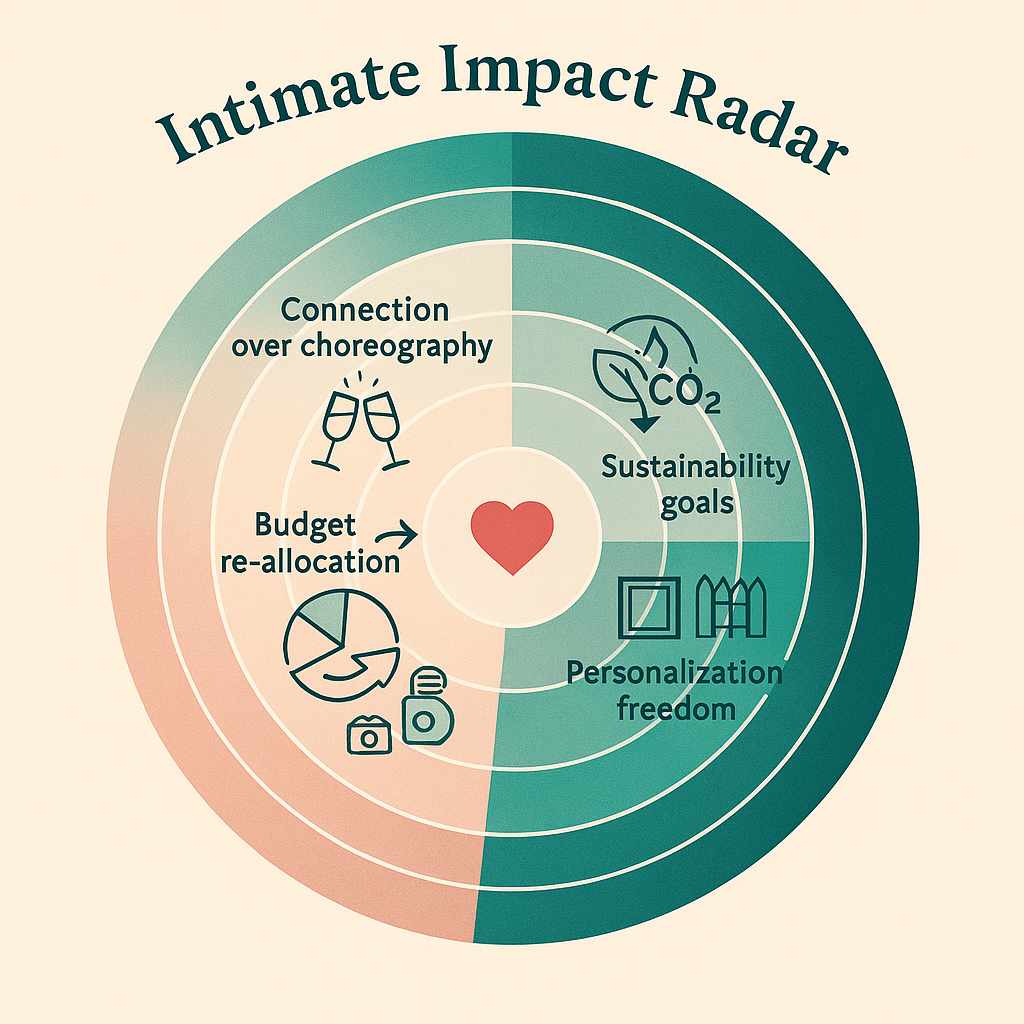The Origin Story of the “Tiny I Do”
The first wave of micro‑ and mini‑weddings wasn’t a style statement at all—it was a public‑health necessity. Guest caps introduced in 2020 forced couples to swap 200‑person banquets for 20‑person backyard toasts.
Yet once restrictions lifted, many pairs discovered that intimate celebrations felt less stressful and more meaningful, igniting a bigger‑than‑COVID conversation about how many people truly need to witness a vow exchange.
What the Numbers Tell Us
Hard data suggests the pendulum is not swinging as far toward “tiny” as Instagram captions might imply. The 2023 Real Weddings Study found the median U.S. guest count holding steady at 115—virtually unchanged from 2022.
Meanwhile, the 2025 First Look Report by planning giant Zola reports that only 6 percent of upcoming weddings will host fewer than 50 people, and just 14 percent will stay under 75.
Inside Ariana Grande’s and Dalton Gomez's intimate at-home wedding ceremony, shared exclusively with Vogue. pic.twitter.com/NRTyfpBbAc
— Couture is Beyond (@CoutureIsBeyond) May 26, 2021
Most couples still expect 100‑plus loved ones at the reception even while listing “small guest list” as one of the trendiest ideas for the year.
In short: micro‑weddings dominate social feeds, but “macro with a micro vibe” rules IRL.
Why Couples Still Crave Brevity
Connection over choreography
Fewer tables mean more face‑time. Small‑wedding advocates say they remember every hug, toast, and dance because they aren’t doing laps around a cavernous ballroom.
Budget re‑allocation
When the head‑count drops, line items like dinner, rentals, and floral centerpieces shrink accordingly—freeing cash for a live band, a custom menu, or a knockout photographer.
Experts note that weddings with 50‑75 guests average $21,500, far below the $45,000 price tag attached to 150‑200‑guest affairs.

Sustainability goals
Environmental advocates point out that each additional guest raises the travel footprint, food waste, and décor consumption. Guides also consider trimmed lists as the fastest route to a greener celebration.
Personalization freedom
With 30 chairs instead of 300, couples can host ceremonies in art galleries, private gardens, or even boutique inns that physically can’t fit a crowd.
Louisiana venue Cajun Mansion spotlights this in its Micro‑Wedding Trends 2025 roundup, stressing that coziness lets décor and menus become bespoke rather than one‑size‑fits‑all.
The Downsides We Don’t Post About
Intimacy comes with trade‑offs. Cutting a cousins’ table can trigger family politics; childhood friends left off the list may feel blindsided.
Large cultural or religious communities may view a sparse guest count as a snub rather than a stylistic choice. Finally, some couples discover that they like the roar of a packed dance floor and the once‑in‑a‑lifetime chance to have everyone they love in one room.
When Bigger Still Makes Sense
For some celebrations, a generous guest list remains not just appropriate but essential. Robust cultural traditions—such as South Asian baraats, Filipino money dances, and Nigerian owambes—draw their power from the collective energy of a crowd, and trimming numbers can unintentionally dilute these beloved rituals.
Best wedding reception ever! The bride & groom (Jodi & Mel..the best friends ever❤️) had everyone dance to @TheFitMarshall 😁🙌🕺💃🏻 pic.twitter.com/Gf8eSBVNmw
— Drew Scott (@MrDrewScott) October 7, 2017
Destination weddings, too, often benefit from fuller attendance; when guests have already committed to passports, plane tickets, and time off work, couples may embrace a “the more the merrier” mindset to justify the journey and maximize the hours spent together.
Blended families also face unique dynamics: second marriages or large webs of step‑relations can require an inclusive approach to prevent hurt feelings and foster unity.
In each of these scenarios, a larger gathering becomes the most diplomatic—and, for many, the most joyful—choice.
How Vendors Are Adapting
Catering teams now quote two menus: one for 150 and a chef’s‑table option for 15. Photographers sell four‑hour micro‑packages alongside classic ten‑hour coverage.
Venues advertise weekday elopement rates yet still book Saturday blowouts. In effect, the industry hedges its bets—ready for whichever direction guest counts blow next.
The Sustainability Factor
Multiple 2025 eco‑trend reports argue that guest travel is the single largest emissions driver in a wedding budget.
Encouraging local venues, digital invitations, and smaller head counts can slash the event’s CO₂ output. Couple that with thrifted décor and seasonal menus, and an intimate wedding moves from lifestyle choice to climate action.
Are Small Weddings the New Normal?
Probably not—but their influence is lasting. Planning resources predict that guest counts will hover around the 100‑mark for the foreseeable future, yet the mind‑set cultivated by micro‑celebrations—intentional spending, guest experience, and planet‑friendly logistics—will shape even the largest ballroom bash.
Bottom line
Smaller weddings aren’t a fleeting fad, nor are they poised to replace big parties altogether. Instead, they have expanded the menu of what “a wedding” can look like.
Whether you toast with 20 people or 220, the challenge (and the joy) lies in curating a guest list that matches your values, budget, and vision—no apologies required.

